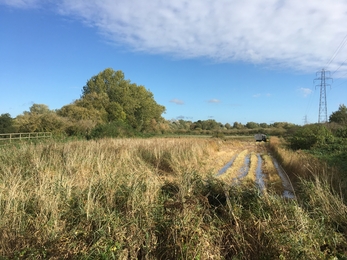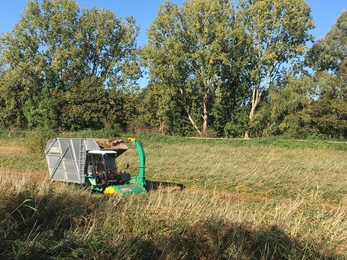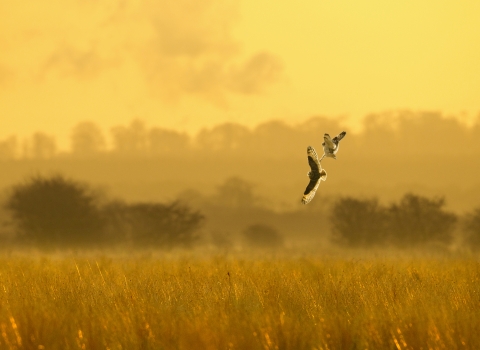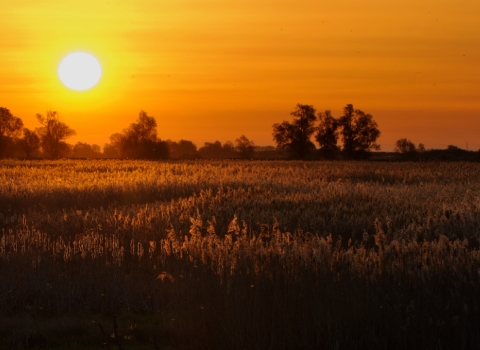With the boardwalk in urgent need of repair due to damage from flooding, vandalism and general wear and tear, and the reedbed, lake and tree habitats in need of restoration, vital work at Woodston Ponds, Peterborough has now been completed thanks to funding of £7,700 by the FCC Communities Foundation (formerly Wren). The work involved brought complexities of contractor choice due to the nature of the work which needed doing and complicated restrictions of site access. A further £2,000 came from the Jack Patston Charitable Trust; all funds have been very gratefully received.
Woodston Ponds Refreshed
Aidan Matthews and John Kerr (NE) at Woodston Ponds by Justin Tilley
Tree restoration
Being next to the River Nene, there are many species of mature bankside trees, so falling stems or branches can present issues for river navigation by boats. Contractors with appropriate experience of the conservation approach to tree surgery and the skills to perform aerial operations were appointed. Several trees had branches and stems reduced, especially where leaning over the river or boardwalk - or removed where they were compromised or presenting a risk if they fell.
Boardwalk replacement and repair
Main access around the west of the site is by wooden raised boardwalk which circumnavigates the pond giving access to grass paths to reach the eastern pond viewpoint. The boardwalk was installed more than 12 years ago and been subjected to various factors which reduced its longevity. With high humidity the materials are prone to rotting – board replacement is a labour intensive task, and efficiency is increased by replacing sections instead of single boards.
Contractors can be hard to find for this work, with access to the site further restricting choice due to the distance from the main site entrance and a railway crossing. Over a week contractors completed the replacement of nearly 60m of boardwalk: old defective boards were removed to be replaced with new bearers, surface boards and non-slip netting. Several other sections with compromised boards were replaced, plus bridges, steps, handrails and ramps have also had repairs made.
Reedbed restoration
Plans were drawn up with a contractor with specialist aquatic equipment in December 2018 for work to start before birds started nesting in March 2019, but then had to be stalled due to site conditions. Work was then postponed until after nesting season late August or September, and with uncertainty over flooding on site a variety of methods were researched, including hand cutting, excavator slubbing and reed harvesting - also availability of contractors to complete the task.
The reed harvester option was chosen - utilising machinery with a low ground pressure wide rubber track, flail/mulcher cutter head, ejection chute and tippable hopper; these are extremely specialist machines mostly used in the Broads, Somerset Levels or marshlands of Lincolnshire. The Natural England team based at Woodwalton Fen in Cambs have such a machine and kindly agreed use on a quid pro quo labour basis. Weighing around 3.5 tons, 2.5m wide and almost 3m tall, the Loglogic Softrack machine would require significant height clearance along the access route for the machine. Trust staff had to create the required headroom and discuss alternative options with Nene Valley Railway (NVR) and Peterborough City Council (PCC), as the normal railway crossing had been vandalised. Site access to the reed bed is via a steep slope which needed modification by a 6ft tracked excavator, which also helped open up the gateway approach from a cycle-track and removed a section of the boardwalk. The Softrack was eventually transported from the NE site via tractor trailer and escorted across the railway and cycle-track.
John Kerr, of the NE team, operated the Softrack, enabling reedbed cutting work in wet conditions in a sensitive manner. Its low ground pressure doesn't cause compaction and damage the sensitive soils, and by collecting all the cut material as it moves along, avoids leaving cuttings to rot on the wetland areas – which would create problems with nutrient enrichment. So just a few hours work with the machine saved days worth of further strimming and raking.
And finally . . .
Two site entrance welcome boards and an interpretation cabinet have also been installed. The new boards highlight the reserve to passers-by and encourages them to enter - as an ex-industrial site in an urban area, some are unsure about the whether they are allowed in. The sign raises the profile of the Wildlife Trust to the local community, and describes the practical achievements of the funded items, touching on the impacts to the community and environment. The long term benefit of the grant funding and accompanying work it has provided has brought heightened visitor experience and enjoyment.




